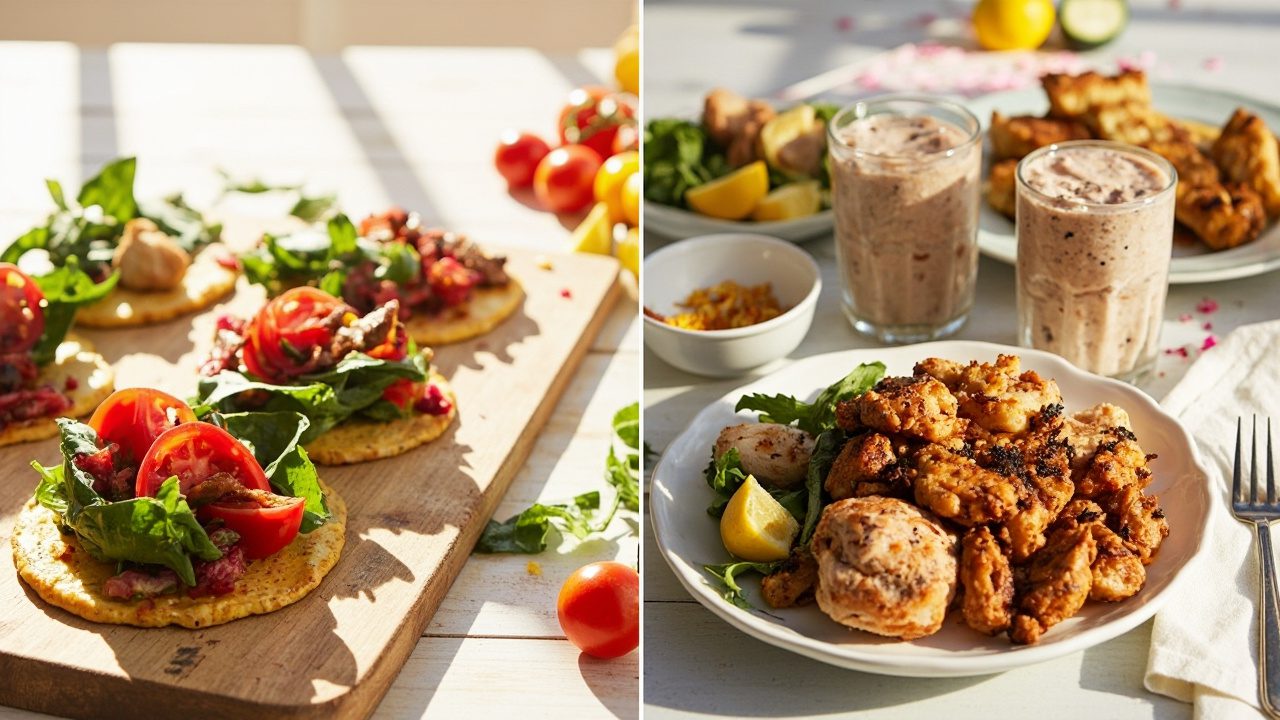Introduction
Iran’s culinary heritage is like a fascinating tapestry that has been woven through many centuries of history and tradition while also being influenced by different regions. Every dish has a story to tell because it reflects the rich flavors and vibrant culture that makes this nation remarkable. Iran cuisine recipes provide a true feast for the senses because they combine spices herbs and cooking techniques in a unique way. They offer an array of tastes which are comforting and also exotic.
In Tehran’s busy bazaars and the calm views of Shiraz, each area has its unique food treasures. Aromatic rice dishes and succulent kebabs or fragrant stews are all made with a deep sense of care and passion in every meal. Pride is taken by Iranians in their hospitality as they often serve big portions to share with family and friends.
In this article, some of the most beloved recipes from Iran cuisine will be explored by us which are full of flavor and soul. Get ready to start a food adventure that will take you straight to the center of Iran!
Essential Ingredients in Iranian Cuisine
The food from Iran shows a lively mix of tastes colors and smells that come from the country’s deep history and different landscapes. In the center of this cooking tradition is a group of key ingredients which really show its special character.
- Saffron: Saffron which is called the world’s most expensive spice adds a special golden color and a rich smell to dishes such as rice and stews.
- Turmeric: This bright yellow spice is often found in many Iranian recipes where it adds not just color but also gives a warm flavor to meats and lentils.
- Cumin: Cumin is often found in ground form or whole seeds and it brings a nutty and earthy flavor to many dishes like kebabs and rice.
- Sumac: Sumac has a flavor that is lemony and tangy so it is often used on salads grilled meats and rice to make the taste experience better.
- Rosewater: Rosewater is an important ingredient in lots of Persian desserts and rice dishes because it gives a delicate floral flavor which makes sweet recipes taste better.
- Pistachios and Almonds: Often in savory dishes and also in sweets, these nuts are used. They give a crunchy texture and a rich flavor that complements the spices.
What makes Iranian cuisine so unique and appealing are these ingredients together with fresh herbs and produce of high quality. For anyone who wants to dive into the tasty realm of recipes from Iran understanding them is very important.

Classic Persian Dishes
Persian cuisine shows the rich history and culture of Iran and it reflects this through a variety of flavors which are unique as well as heartwarming. Iran’s classic dishes are famous because of their vibrant colors fresh ingredients and aromatic spices. If you are really interested in exploring these culinary treasures then some traditional recipes here will definitely make your dining experience richer.
- Chelo Kabab: This famous dish includes skewers that are grilled with marinated meat which usually is lamb or chicken and they come with fluffy rice and some grilled tomatoes on the side. The saffron is often used to give flavor to the rice for a really nice smell so it becomes a perfect partner for the tasty kabab.
- Fesenjan: Fesenjan is a rich stew that is slow-cooked and made with ground walnuts plus pomegranate molasses. Traditionally it is cooked with chicken or duck and it offers a delightful mix of sweet flavors along with savory ones which represent Persian cooking.
- Gheymé: This stew is hearty and it contains yellow split peas that are cooked together with beef and tomatoes along with a hint of lemon. Crispy fried potatoes are often on top. Usually it is served on Persian rice which creates a meal that is comforting and shows the diverse taste profiles of Iranian recipes.
- Tabbouleh: A salad that is refreshing has parsley chopped fine, tomatoes, and bulgur wheat in it while olive oil and lemon juice is drizzled on top. This dish is light but it also brings a lot of flavor which makes it a great side for heavier meals providing a nice balance in the meal.
- Sabzi Polo Mahi: A dish of fragrant herb rice is often enjoyed with fried fish during special occasions. The combination of fresh herbs in the rice adds flavor and when it is served next to crispy fish it creates a delightful mix of textures and tastes.
- Baghali Polo: This rice dish is full of flavor and it has dill along with fava beans. Often it gets served with lamb shanks which shows the heart of Persian cooking as it illustrates how basic ingredients can create flavors that are really complex.
Every one of these classic dishes does not only serve as a meal but also becomes an experience that shares a story about the culture and hospitality of Iran. By preparing these recipes you get to enjoy the true heart and soul of Iranian cuisine right from your own kitchen.
Regional Variations in Iran Cuisine
The cuisine of Iran shows a vibrant tapestry that is made from different cultures and climates found in its regions. Every area offers unique flavors and ingredients plus different cooking styles which makes a rich culinary scene that shows the history and geography of the nation.
From the green forests found in the north to the dry deserts located in the south there are several regional variations that are notable.
- Tehran: Tehran serves as the capital and it has a mix of flavors that is really unique. Dishes that are popular are kebabs and stews and they usually come with rice that has saffron in it.
- Isfahan: Isfahan is known for its sweet dishes and delights people with specialties such as Biryan. This fragrant rice dish mixes meat with a variety of spices and it is often served along with a rich sauce.
- Shiraz: Known for the use of fresh herbs this region is famous. Khoresht-e Fesenjan a stew made with pomegranate and walnut must be tried because it captures the essence of Shiraz’s deep culinary tradition.
- Tabriz: In Tabriz you can find hearty dishes like Kufteh Tabrizi which is a big meatball filled with rice and spices and it shows off the traditional ways of cooking and the ingredients from the area.
- Ahvaz: Ahvaz cuisine is characterized by the rich use of lamb and spices. A beloved herb stew is Ghormeh Sabzi that shows how much the region loves aromatic flavors.
When you look at Iran cuisine recipes these regional specialties are only the beginning of what you can find. Every dish has a story to tell and it connects families and communities through shared meals and traditions across generations. Explore these tasty variations while you find out how each recipe you try is enriched by Iran’s rich culinary diversity.
Vegetarian Options in Iranian Cooking
Iranian cuisine holds a treasure trove of flavors and it gives many delicious vegetarian options which highlight the rich diversity and unique ingredients that come from the region. It doesn’t matter if you have been a vegetarian for a long time or you just want to try some plant-based meals, the options below will excite your taste buds and feed your soul.
- Mirza Ghasemi: A dip that is smoky and made from roasted eggplants tomatoes garlic and turmeric often gets served with bread. The essence of Persian flavors is captured by this dish.
- Fesenjan: Traditionally this hearty stew is made with meat but you can adapt it by using walnut and pomegranate sauce to create a delightful vegetarian version. The mix of sweetness and tartness makes it irresistible.
- Khoresh-e Bademjan: A tasty stew made with eggplant cooked together with tomatoes lentils and spices is simmering. This dish goes really well with rice and it makes a meal that feels comforting.
- Dolmeh: Grape leaves they are filled with rice lentils herbs and sometimes nuts. These tasty bundles are a great choice for appetizer or side dish.
- Kookoo Sabzi: A frittata that is full of aromatic herbs such as parsley and cilantro along with dill is made with either eggs or chickpea flour which creates a satisfying meal.
- Sabzi Polo: This dish is a classic herbed rice and it is often served alongside different stews. With a vibrant mix of herbs, it brings any meal to a higher level while also celebrating the freshness that comes from Iranian ingredients.
In Iranian cooking the vegetarian options show not only the depth of flavor that is found in Iran’s cuisine recipes but they also reflect culture and traditions of the country. Every dish gives a taste experience that is unique and it is sure to please anyone who is looking for adventures in plant-based cooking.
Sweet Delights: Persian Desserts
Persian desserts they celebrate flavors in a vibrant way and show the rich cultural heritage that belongs to Iran. A delightful selection of sweets is often seen to include aromatic spices along with fruits and nuts which makes every bite a memorable experience. In this list you can find some famous Persian desserts along with how they are made.
- Baklava: This pastry which is really rich has layers of thin filo dough that are filled with chopped nuts and sweetened either by syrup or honey. To prepare it, each layer of dough must be brushed with melted butter and then it is layered with nuts before baking it until it becomes golden brown and after that soaking it in a fragrant syrup that is made from sugar water and rose water.
- <strong*Saffron Rice Pudding (Shirin Reshteh): This pudding is a creamy dessert that mixes rice with milk and sugar plus saffron and it is often topped with pistachios and almonds. Slowly the rice is cooked until it becomes tender and then it gets mixed with milk that is sweetened and infused with saffron. Served chilled or at room temperature this dish makes for a favorite at gatherings.
- <strong*Zoolbia and Bamieh: Deep-fried dough pastries soaked in syrup are what these traditional sweets are. Zoolbia has a spiral shape but Bamieh looks like small fritters. With cardamom and saffron in the batter, a delightful crunch and sweetness is created that goes well with different teas.
- <strong*Faloodeh: Faloodeh is a dessert that is refreshing and made of thin rice noodles which are mixed with rose water plus sugar and lime juice. Often it has a texture similar to sorbet. Crushed pistachios are used traditionally as a garnish or it can be served with sweet syrups to add more flavor.
- <strong*Persian Ice Cream (Bastani): This ice cream is rich and creamy because it has saffron and pistachios inside. Made from milk and sugar, the base is whipped to perfection and sometimes a unique ingredient is included which is salep that is a flour from wild orchid tubers to give that authentic texture.
These tasty desserts play a big role in the lively world of Iran Cuisine Recipes because they show how sweetness and spice are balanced in a way that really defines Persian cooking traditions.
Cooking Techniques Unique to Iran
Iran’s culinary landscape is very rich and diverse. It is shaped by a unique set of cooking techniques which give distinct flavors and soul to the dishes. Through generations, these traditional methods have been passed down so the essence of Iran cuisine recipes stays intact.
- Slow Cooking: A lot of dishes from Iran are made by using slow cooking methods. This kind of technique helps flavors mix together in a beautiful way and it creates meals that are both complex and aromatic.
- Layering Flavors: Often Iranian cooks they layer spices and ingredients in the cooking process. By doing this it enhances the depth of flavor which makes each bite a experience that is memorable.
- Steaming and Braising: In many dishes such as khoresh steaming is often used because meats and vegetables are braised really well. This way moisture and nutrients are kept which makes the dish more rich overall.
- Use of Saffron: Saffron is really important in Iranian cooking. When dishes are infused with this valuable spice it makes the flavor better and also gives a bright color that looks nice.
- Grilling on Skewers: Skewered meats are called kebabs and they represent a staple in Iranian grilling. This method of cooking quickly happens over an open flame which creates a smoky flavor that really complements the juicy meats.
The heart of Iranian culinary traditions is reflected by these techniques which emphasize how important patience is and also attention to detail and an appreciation for quality ingredients. When you use these methods in your cooking, a bit of Iranian cuisine recipes will come into your kitchen and it will enrich your culinary skills.
Pairing Iranian Dishes with Beverages
While you enjoy the rich tastes of Iran Cuisine Recipes, choosing the right drink can make your dining experience much better. If tea or wine is what you like more, then perfect pairings are there for you to find.
- Tea with Kebab: Grilled kebabs have smoky flavors that go really well with a glass of traditional Persian black tea. The strong taste of the tea works to complement the meat and also refreshes the palate at the same time.
- White Wine with Fesenjan: The fesenjan which is a stew made from walnuts and pomegranates has both sweet and sour notes that go well with a light white wine such as Sauvignon Blanc. This pairing makes the dish more complex in flavor.
- Rose Water Tea with Desserts: Sipping a chilled rose water tea while having traditional sweets such as baklava is really enjoyable. The drink’s floral notes make the syrupy richness of the dessert even better.
- Red Wine with Ghormeh Sabzi: A dish that is hearty like ghormeh sabzi which has herbal hints goes well with a red wine such as Shiraz. The full-bodied quality of the wine matches the deep flavors of the dish.
Discovering these combinations could add a lovely surprise to your Iranian dishes while making a feast for your senses that is unforgettable.
Conclusion
When you explore Iran Cuisine Recipes, you discover a rich tapestry of flavors along with cultural heritage that can turn any meal into an experience of celebration. Every dish tells a story that is steeped in tradition starting from the aromatic spices of saffron and going to the vibrant freshness of herbs.
- Diversity of Flavors: In Iran’s food scene you can find a mix that is unique with sweet and savory along with tangy flavors which make the taste buds come alive.
- Cooking Techniques: The ways that these dishes are prepared they enhance their flavors and the soul of each recipe is brought out.
- Encouragement to Explore: Explore these Iran Cuisine Recipes while you enjoy the process of making meals that are full of love for your family and friends.
Let your kitchen adventures be inspired by the depth of Iranian cooking!
Discover more Iran cuisine
learn Also on Miameals Hyderabad Wala Recipes You Must Taste to Believe!










Leave a Reply